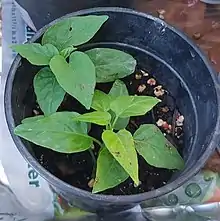Ipomoea macrorhiza
Ipomea macrorhiza is an extremely rare species of tuberous, night-blooming morning glory native to the Southeastern United States.[2][1]
| Ipomoea macrorhiza | |
|---|---|
 | |
| Seedlings | |
| Scientific classification | |
| Kingdom: | Plantae |
| Clade: | Tracheophytes |
| Clade: | Angiosperms |
| Clade: | Eudicots |
| Clade: | Asterids |
| Order: | Solanales |
| Family: | Convolvulaceae |
| Genus: | Ipomoea |
| Species: | I. macrorhiza |
| Binomial name | |
| Ipomoea macrorhiza | |
Description
This is a vigorous vine with stems growing up to 20 feet long. It has large, tuberous roots and white-and-pink flowers that bloom at night.[2] The leaf shape is highly variable, ranging from triangular to palmate.[3][2] The seed capsules contain 3-5 pubescent seeds.[2]
Cultivation
This plant is rare and so is not widely cultivated. However, its roots are edible and the plant was cultivated by Native Americans as a food source.[4] I. macrorhiza is also of ornamental value due to its attractive flowers.
References
- "Ipomoea macrorhiza - Species Details". Atlas of Florida Plants. Retrieved 2021-11-11.
- "Ipomoea macrorhiza - Species Page - APA: Alabama Plant Atlas". floraofalabama.org. Retrieved 2021-11-11.
- "Herbarium Specimen Details - ISB: Atlas of Florida Plants". florida.plantatlas.usf.edu. Retrieved 2021-11-11.
- "Ipomoea, Eat The Weeds". www.growables.org. Retrieved 2021-11-11.
This article is issued from Wikipedia. The text is licensed under Creative Commons - Attribution - Sharealike. Additional terms may apply for the media files.